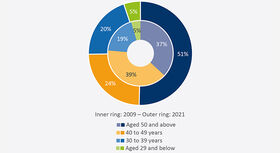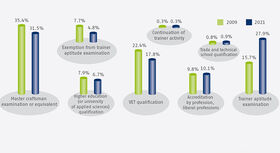In-company trainers in IVET in figures
Anke Bahl, Verena Schneider
In-company trainers play a key role in training apprentices at the workplace. Despite the group’s system relevance for initial vocational education and training (IVET) in the German dual system, there are major gaps in the statistics. This article examines existing data and highlights possible ways to improve the data basis.
Heterogeneity of training staff remains invisible
In-company trainers are a heterogeneous group of employees with vastly different places of work. There is also an enormous variance with regard to personnel structures and qualifications. Unlike at the learning venue of the vocational school, the execution of training tasks at the company is not linked with a certain professional status. Instead, this is a function which is shared across many different individual employees. In practical terms, such a circle includes all persons involved in any way in the training of apprentices. Depending on the perspective adopted, they are classified in the relevant literature in accordance with their legal position, their specific qualification, their company function or their task profile, i.e. the training-related activities they perform.
Within the meaning of the Vocational Training Act (BBiG), the designation of “trainer” solely applies to persons at the company location who bear legal responsibility for proper execution of training for the respective occupational profile. These persons are registered by name with the competent body, and their number is recorded on an annual basis in the Vocational Education and Training Statistics of the Federal Government and of the federal states together with various related characteristics. For this reason, the following remarks primarily concentrate on this group.
Number of registered trainers currently in decline

Foto-Download (Bild, 219 KB)

Figure 2: Age of training staff 2009 and 2021
Foto-Download (Bild, 153 KB)
Although the number of registered trainers rose more or less steadily from the time when statistical surveys were introduced in 1977 and reached a peak of 676,428 persons in 2009 (cf. Bahl/Brünner 2013, p. 517), this was followed by a sharp decrease which continued until 2020. In 2021, 628,281 employees were registered trainers (cf. Figure 1). The main explanation for this falling trend is declining participation in apprenticeship training on the part of the economy. This development was most recently exacerbated by the outbreak of the coronavirus pandemic. The greatest fall (of just over 15,000 persons) thus took place between 2019 and 2020. If we consider this development in accordance with the two major sectors involved in apprenticeship training, then the large decrease in the craft trades sector outweighs. From 2010 to 2020, the number of trainer registrations in this sector fell by 54,276, a decline of just over a fifth (21.4%).
Men accounted for 74 percent of registered trainers in 2021. The group thus continues to be male dominated. The proportion of women rose only slightly between 2009 and 2021 (from 23.4% to 26%). Age has also increased significantly in overall terms. In 2021, half of all registered trainers were aged 50 or above (cf. Figure 2).
In-company trainers in IVET
The bigger a company is, the larger its division of labour and degree of specialisation will be. A distinction is generally drawn between four functions (cf. Huismann/Hippach-Schneider 2022, p. 19)
- Training managers (planning and management level, administration)
- Full-time in-company trainers at training workshops/training laboratories (planning and implementation level, administration)
- Part-time in-company trainers (implementation level)
- Skilled workers providing training (implementation level)
According to the Vocational Training Act (BBiG) it is incumbent upon the company providing training to make suitable training staff available (§§ 14 and 28).
Lack of figures regarding the actual number of company employees delivering training
The number of in-company trainers with formal responsibility is not very meaningful in terms of determining the size of the group of persons involved with the practical training of young people on a daily basis. Apart from the annual survey of registered trainers, relevant statistics are very thin on the ground. Firstly, we do not know how many trainers pursue their task on a full-time basis, i.e. are employed in a dedicated role in this regard. Secondly, no information is available as to how many company employees support the registered trainers by acting as assigned part-time trainers of other divisions or skilled workers.
Although the Vocational Education and Training Statistics include further information of interest in respect of the vocational and occupational pedagogical qualifications of in-company trainers, these indications are not easy to interpret.
Vocational and occupational pedagogical qualification pursuant to the AEVO as a recognised standard

Registration of employees as persons responsible for training is dependent upon evidence of their personal and professional suitability (§ 28 f. BBiG). Since the introduction of the Ordinance on Trainer Aptitude (AEVO) in 1972, the aim has been for professional suitability to also encompass a vocational and occupational pedagogical aptitude which is acquired via (voluntary) participation in a relevant ‘training of trainers’ programme and successful completion of the trainer aptitude examination. This is usually already a regular constituent component of master craftsman qualifications in industry and in the craft trades. There are also employee groups which do not (need to) comply with the AEVO. In 2021, just over 59 percent of registered trainers had obtained evidence of aptitude in the form of the AEVO (31.5% as part of their master craftsman examination or within the scope of an equivalent examination) and 27.9% via a separate examination. This is the highest rate recorded since the statistical surveys began. There is also the complementary circumstance that the proportion of those whose only qualification is their VET qualification/profession has fallen continuously to the present level of 17.8 percent. The remaining 22.8 percent fall into various categories. The largest share is made up by members of the liberal professions, who are not required to provide evidence of aptitude (accreditation by profession: 10.1%).
There has generally been a very high demand for the trainer aptitude examination as a central and cross-cutting qualification since the AEVO was reinstated in 2009. Even in the first pandemic year of 2020, 76,446 persons across all areas of training still successfully completed the examination. Master craftsman examinations accounted for significantly over a third of these (32,394 or 42%).
But what is the picture with regard to demand for further vocational pedagogical qualifications for in-company trainers? In 2009, two cumulative and nationally standardised upgrading programmes were created in the form of the advanced training qualifications of ‘certified initial and continuing education pedagogue’ at level 6 of the European Qualifications Framework (EQF) and ‘certified vocational education pedagogue’ at level 7 EQF. Demand here has fallen far short of expectations. In some individual years, fewer than one hundred persons have completed a relevant advanced training programme. Considerable fluctuations in examination pass rates have also been recorded. All in all, this represents evidence pointing to a need for revision of upgrading training programmes beyond the AEVO.
Initial approaches towards illuminating the black box
Data from official statistics offers only limited suitability in terms of adequately describing the heterogeneous group of in-company trainers. This makes the fact that such personnel are currently becoming a closer focus of quantifying investigations even more gratifying. In April 2021, 3,885 trainers were surveyed online (cf. Härtel et al. 2021) within the context of a study looking at the need to evaluate the AEVO. As a result, the framework curriculum of the AEVO is presently being revised. Further to this, 1,004 trainers from member companies of the trade union IG Metall took part in a survey on their situation in the workplace in June 2021 (cf. Nicklich/Blank/Pfeiffer 2022 and the article by this team of authors in the present issue). BIBB is preparing to use its Establishment Panel on Qualification and Competence Development as a vehicle for identifying information relating to the various functions of training staff at company level. Initial consideration is also being given to acquiring representative structural data and information on working conditions within the scope of the next BIBB/BAuA Employment Survey. The objective must be, however, the permanent improvement and systematisation of the data situation. This is a prerequisite for the development of tailored qualifications and support provision, both for trainers and for the companies themselves, and may go some way towards countering any further depletion in the number of companies providing apprenticeship training.
Literature
Bahl, A.; Brünner, K.: 40 Jahre Ausbilder-Eignungsverordnung – Eine Bestandsaufnahme zu ihrer pädagogischen Relevanz für betriebliches Ausbilderhandeln. In: Zeitschrift für Berufs- und Wirtschaftspädagogik 109 (2013) 4, pp. 513–537 – URL: https://lit.bibb.de/vufind/Record/DS-164986
BIBB: Datenreporte zum Berufsbildungsbericht 2010-2022 (Chapter „Ausbildungspersonal in der betrieblichen Ausbildung“). Bonn 2010– 2022 – URL: www.bibb.de/datenreport/de/index.php
Härtel, M.; Zöller, M.; Kupfer, F.; Schneider, V.; Mpangara, A. S.: Kurzstudie zur Prüfung des Evaluierungsbedarfs der AEVO. Abschlussbericht Projekt 2.2.355. Bonn 2021 – URL: www.bibb.de/dienst/dapro/daprodocs/pdf/eb_22355.pdf
Huismann, A.; Hippach-Schneider, U.: Teachers and trainers in a changing world – Germany: Building up competences for inclusive, green and digitalised vocational education and training (VET). Cedefop ReferNet thematic perspectives series 2022 – URL: http://libserver.cedefop.europa.eu/vetelib/2022/teachers_and_trainers_in_ a_changing_world_Germany_Cedefop_ReferNet.pdf
Nicklich, M.; Blank, M.; Pfeiffer, S.: Ausbildungspersonal im Fokus. Studie zur Situation der betrieblichen Ausbilder*innen 2021. Nürnberg 2022 – URL: https://wap.igmetall.de/docs_FAU_-_Ausbilder_innenstudie__2022__f8161b3a1a38f9ccbf2c0f4ce500422dd3100804.pdf
Statistisches Bundesamt: Bildung und Kultur. Berufliche Bildung (Specialist Publications Series 11, Series 3, Volumes 2009–2021). Wiesbaden 2010– 2022
Further material
The absolute number of registered in-company trainers from 2009 to 2021 in tabular form may be found as an electronic supplement at: www.bwp-zeitschrift.de/dienst/veroeffentlichungen/en/bwp.php/en/bwp/grafik/660/download
Figure 3 to download: www.bwp-zeitschrift.de/dienst/veroeffentlichungen/en/bwp.php/en/bwp/grafik/657/download
(All links: status 22/11/2022)
Dr. Anke Bahl
Academic researcher at BIBB
Verena Schneider
Academic researcher at BIBB
Translation from the German original (published in BWP 4/2022): Martin Kelsey, GlobalSprachTeam, Berlin